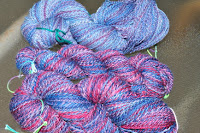Equipment-
canning sealer jars - quart or litre. I used both sizes.
Clean wool fibre
Dyes - Acid, Food Colours, Fibre Reactive
additives for each dye -
vinegar or citric acid
synthropol for Fibre Reactive Dyes
quantities -
 Wool enough to fit in jar allowing water to circulate
Wool enough to fit in jar allowing water to circulate1/4 c vinegar
water to top up
dyes - a few ml of fibre reactive or acid dyes
dabs of food colours
synthropol if using fibre reactive dyes
Method -
Soak wool fibre in water for at least an hour before starting dyeing.
Add vinegar and some water to jar.
Add water saturated fibre to jar.
Top up with water.
Add dye and sythropol if needed.
I just dabbed the food colours in various placed on the fibre. I used a craft stir stick to add the food colour. It only took a tiny bit to get a lot of colour. With the Fibre reactive dye, I used a syringe to measure out a few ml of dye and added it lower down on the fibre.
Add lids to jars and set in the sun to warm up. They need to get to about 185 degrees for an hour or so.
This time of year, at our more northern location, the sun is too low in the sky to warm up the dyes in the jars. I ended up steaming the jars to get the dye to exhaust. (remove the lids first). You could put them in a dark plastic bag, your car in the sunshine or paint the jars black to absorb more heat.
It was fun to do but really, it's just a small amount of fibre, so not really productive here unless you have a lot of jars going. Earlier in the summer, one could probably spray paint buckets black and do larger amounts in the sun - maybe some sort of foil reflector would help. I also think that further south, this is likely a much more effective method of dyeing.
So fun, but not effective in late August, in my back yard or front yard, since I tried both. Not enough fibre dyed for my projects or preference. I generally like to dye in at least 100 g quantities. Would I do this again? Maybe, earlier in the year. A few years ago I did a lot of indigo vats using the painted buckets, starting in June and it was pretty decent results.





















